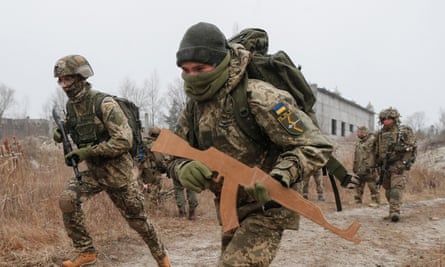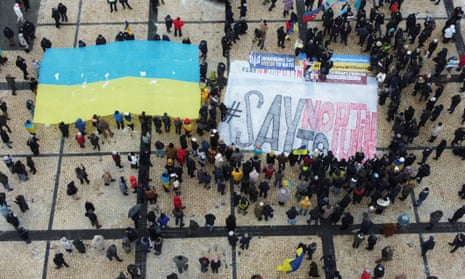The mood last week in Ukraine was eerily calm, despite talk of war. The first winter snow blanketed Kyiv. Many were still celebrating Orthodox Christmas – which falls on 7 January – or had left town for the holidays. Bars and restaurants rang out with Dean Martin’s Let It Snow!, while the fir trees in Independence Square looked like a mini-Narnia.
Sure, Russia might invade at any moment. But, as Ukrainians wearily point out, the country has already been at war for eight long years, ever since Vladimir Putin annexed Crimea and kickstarted a brutish conflict in the east of the country, which has claimed nearly 14,000 lives. Friday’s dawn cyber-attack on government websites was merely the latest in a series of hostile acts.
What to do in the event of a military operation by Moscow, and whether to stay, flee or fight? The consensus – at least according to surveys – is that a third of the population is ready to take up arms. In the upmarket Podil district, with its art deco mansions, a new piece of graffiti read: “Biy Moskaliv!”(“Beat Up Russians!”)
Sitting in a law office just across the road, Serhii Filimonov explains what he intends to do, should the Kremlin attack. “There are about 50 of us. We will meet and decide where we can best fight,” he said. His group is made up of middle-class professionals: IT staff, designers, actors, journalists. Filimonov runs a security business and starred in a film shown at Venice.
None of this is likely to alarm Russia’s defence ministry, which has sent 100,000 troops to Ukraine’s border. These include the existing front between the Ukrainian army and the Moscow-run separatist territories of Donetsk and Luhansk in the east, as well as Belarus in the north, Crimea in the south and the breakaway Russian enclave of Transnistria in the west.
But the Kyiv creatives know how to shoot. All are combat-hardened veterans of the 2014 war. Filimonov took part in the bloody battle for Ilovaysk, when the Russian army trapped Ukrainian forces, and was wounded by an enemy mortar strike. After an operation to remove shrapnel, he returned to the front, serving as a volunteer against Moscow with the Azov battalion.
“We have registered weapons. We will defend our homes,” Filimonov said. “Putin wants to go back to the borders of the Russian empire. You can see this in Belarus, Kazakhstan. Here in Ukraine he wants to create a tsarstvo – a tsardom. This is a war of civilisations. It’s the west versus Eurasia, democracy against slavery and authoritarianism. We want democracy and freedom.”
Most experts agree that Russia’s vastly superior army, air force and navy could quickly seize Ukrainian territory. But Andriy Zagorodnyuk, Kyiv’s former defence minister, says the Kremlin’s conscript-heavy military will immediately face resistance, should it try to occupy towns and cities. Volunteers such as Filimonov and small army groups will launch bloody partisan attacks. “There is definitely no panic. I don’t see any panic at all,” Zagorodnyuk told the Observer. He acknowledged Ukraine’s relative military weakness but he said Kyiv had around 500,000 soldiers including reservists. It was ready for guerrilla war “on a huge scale”, he said.
Masi Nayyem, a lawyer who founded the Podil practice, admitted he was looking forward to shooting at Russians again. In 2016 he fought with a paratrooper brigade in Avdiyivka, Ukraine’s frontline position outside rebel-held Donetsk. “In peace time you have to be serious, responsible. In war you don’t have any considerations or need to think about consequences. It’s black and white,” he said.
Talks between Russia and the US, Nato and the Organization for Security and Co-operation in Europe ended last week in a dead end. The Kremlin has demanded assurances from the Biden administration that Ukraine and Georgia will never join Nato. In essence it wants to overturn the post-cold war order – restoring central and eastern Europe as a zone of Warsaw Pact-style Russian influence, from which Nato troops and weaponry are banned.

Beneath the Kremlin’s shrill, tough-man rhetoric lies a mystery. It is unclear why Putin is moving with such strategic haste, demanding that the US and its allies rewrite international security rules in Russia’s favour. His demands are “non-starters”, as the US’s negotiator and deputy secretary of state, Wendy Sherman, put it. Putin’s possible goal, she suggested, was to establish a pretext for war.
Andrew Wilson, professor in Ukrainian studies at University College London, said the timing from the Kremlin’s perspective was opportune. Putin has jailed his chief domestic critic, Alexey Navalny, and squashed Navalny’s opposition movement. Russia was awash with cash, thanks to rising energy prices. On the international stage the Kremlin faces off against a US administration it regards as weak and indecisive.
What could happen next? “Creating a crisis to create opportunities is what they [the Russians] do,” Wilson said. He added: “I don’t think a full-scale invasion is possibility number one. The Ukrainians have pretty successfully advertised the huge cost of invasion and occupation. But Putin has to have a win of sorts, either on European security or Ukraine itself.”
All of which presents observers with a dilemma: how to report on a crisis which does not quite feel like a crisis, and appears largely to exist inside Putin’s head? It is evident that Russia’s president feels emotionally about Ukraine. Last summer he wrote a long essay stating that Ukraine and Russia were “one people”, divided by the whims of Bolshevik map-making and western meddling.
“With nothing yet happening on the ground, there’s nothing I can report to tell you something new and impactful,” Nataliya Gumenyuk, a Ukrainian journalist and author admitted, saying it was hard to make sense of a conflict in which Ukraine often appears as a bystander. She added: “We are caught in the position of waiting for the ‘worst scenario’ without a chance to influence the outcome.”
Gumenyuk said the Kremlin’s goal was to turn the clock back to the early 1970s, before the Soviet Union signed the Helsinki accords guaranteeing human rights – a mistake, in the eyes of Moscow’s current hawkish leadership. Others have argued that Putin’s preferred geo-political model goes back further, to the imperialist 19th century, when mighty great powers over-rolled lesser ones.
In an opinion piece for the New York Times the eminent Russian political scientist Lila Shevtsova said the current stand-off over Ukraine had little in common with the political deals struck at Yalta in 1945, or at the congress of Vienna in 1815. Back then, the participants stuck to the rules. “[Putin’s] aim, really, is a Hobbesian world order, built on disruption and readiness for surprise breakthroughs,” she wrote.
How a surprise breakthrough might morph into war is a topic of conversation inside the Kyiv government of comic-turned-president Volodymyr Zelensky. Little was seen of him last week. Zelensky won a landslide victory in 2019 after campaigning on a platform of peace. Faced with Russian intransigence over the fate of Ukraine’s already occupied territories, he has moved towards Nato and the west.
US intelligence agencies say the risk of invasion is “high”. Their Ukrainian counterparts think Moscow may be planning a “staged provocation”. This could take the form of an attack on Russian citizens – at the embassy or consulate perhaps – or against Russian soldiers in Transnistria. The Kremlin would blame the “attack” on far-right Ukrainian nationalists, with the incident used for propaganda and as a casus belli.
Alex Kovzhun, a political strategist who advised Ukraine’s former prime minister Yulia Tymoshenko, said the Kremlin needed to craft a compelling narrative. “They are obsessed with their TV ratings. All of us Ukrainians are extras in their internal TV show. They are the protagonists. From time to time they change the bad guys. Ukraine is not their favourite location.”
Kovzhun added: “A fantastic postmodern storytelling device is the wink. In 2014 Putin winked when he said there were no Russian units in Crimea. It’s a conspiracy. He invites all Russian TV viewers to share in this conspiracy. He used the wink in Salisbury. Everybody knew two Russian idiots travelled there to kill Sergei Skripal, as part of a special operation.”
It is just possible, of course, that Putin’s brinkmanship is part of an elaborate bluff, the latest in a series of stress tests designed to reveal weaknesses among the west’s ruling class and America. No one – save for the man in the Kremlin – can really know. But Filimonov thinks a storm is coming. “We are convinced something will happen,” he said. “Putin needs Ukraine. An attempt to seize it is inescapable. We will fight until the end.”
